Podcast: Play in new window | Download (Duration: 19:30 — 15.6MB)
This week let’s find out a little something about the Cambrian explosion, where the relatively simple and tiny life on earth suddenly proliferated and grew much larger…and definitely stranger.
The Burgess shale area: beautiful AND full of fascinating fossils:

Anomalocaris, pre-we-figured-out-what-these-things-are:
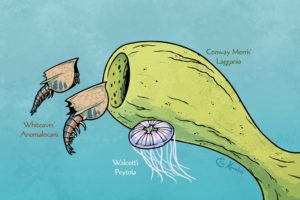
What anomalocaris probably actually looked like, plus a couple of the “headless shrimp” fossils:
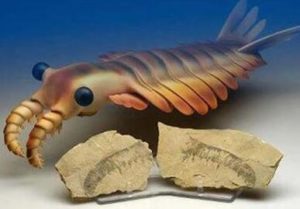
More “headless shrimp” fossils because for some reason I find them hilarious:
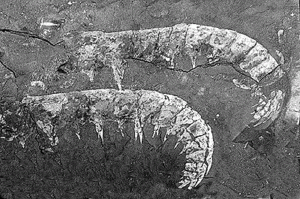
Marrella. Tiny, weird, looks sort of like those creepy house centipedes that freak me out so much, but with horns:
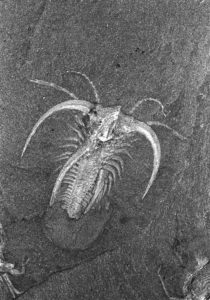
Hallucigenia, long-time mystery fossil:
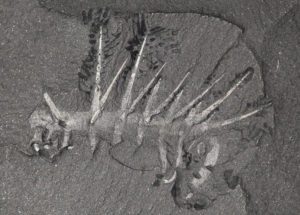
What hallucingenia probably looked like, maybe:
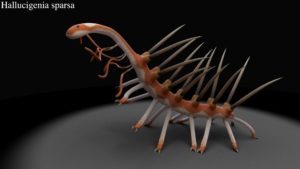
Show transcript:
Welcome to Strange Animals Podcast. I’m your host, Kate Shaw.
This week’s topic is one I’ve been fascinated by for years but I’ve never read much about it: the Cambrian explosion. That refers to the explosion of life forms in the Cambrian period, which started about 540 million years ago. That was long before the dinosaurs, long before fish, basically long before almost all life on earth that wasn’t simple squidgy things living in warm, shallow seas.
To learn about the Cambrian explosion, let’s go back even farther first and learn about the first life on earth.
Obviously, the more recently an animal lived, the more likely we are to find fossils and other remains: footprints in fossilized mud, gastroliths and coproliths, and so forth. The farther back we go, the fewer remains we have. The earth is continually changing, with mountains rising up and continents moving around, volcanoes erupting, old mountains being worn down by wind and weather. That’s good for the earth and therefore for life in general, since nutrients are cycled through the ecosystem and habitats are continually renewed. But it’s bad when paleontologists are trying to find out what lived a billion years ago, because most of those rocks are gone, either weathered into sand long ago, melted into magma, or buried under the ocean or otherwise out of our reach.
The Earth formed about 4.5 billion years ago, oceans formed 4.4 billion years ago, and the oldest rocks we can find are about 4 billion years old. The first life on earth, single-celled organisms, dates back to about 3.8 billion years ago, maybe earlier. By 3.5 billion years ago, complex single-celled microorganisms had evolved—we know because we’ve found eleven microscopic fossils in rocks from western Australia. Researchers have concluded that the fossils belonged to five different taxonomical groups, which means that by 3.5 billion years ago, life was already well established and diverse.
By 2.5 billion years ago, the earth had continents roughly the same size as the ones today, although not anything like the same shapes or in the same places. Land also didn’t have dirt on it, just sand and bare rock, since dirt is largely decomposed organic matter and nothing was living or dying on the land yet. Not long after, 2.45 billion years ago, oxygen started to make up a large part of the earth’s atmosphere. That’s right, before then we literally could not have breathed the air. I mean, we could have, but we would die of suffocation because the air contained only trace amounts of oxygen. While having oxygen in the air sounds great to us now, the single-celled organisms living then couldn’t process it and died off—probably the greatest extinction event in the earth’s history. Only organisms that were able to evolve quickly enough to use oxygen survived and thrived.
One particular type of microorganism dating back 2.3 billion years, sulfur bacteria, again known from ancient rocks from western Australia, is still around. Modern sulfur bacteria live in the deep sea off the coast of Chile, and they literally have not needed to change at all in 2.3 billion years. That’s what you call success.
The earliest multicellular organisms date to around 2.1 billion years ago, or at least those are the oldest fossils we’ve found. Algae and fungi evolved soon after. The earliest animal fossils date from about 580 million years ago and include small jellyfish and sea anemones, but all the oldest fossils we’ve found are of specialized animals so they probably arose much earlier. At about the same time, fossils of more complex shelled animals start appearing in the fossil record, animals which may have been the ancestors of arthropods, echinoderms, and mollusks. We also have fossils of burrows made in the sea floor, although we don’t know what kind of animal made them—some kind of wormy creature, but none have been found, just their burrows. Clearly a lot was going on back then, but it was all on a small scale: tiny worms, colonies of bacterial mats, and shelled animals measured in millimeters.
Then came the Cambrian explosion, starting about 540 million years ago, where diverse and often bizarre-looking animals suddenly appear in the fossil record, proliferating at a rate unheard-of in the previous eras. We’re not completely sure why, but it was probably a combination of factors, possibly including increased oxygen levels, the development of an ozone layer in earth’s atmosphere that protects cells from lethal UV radiation, an increase of calcium in ocean water, and many other factors, large and small. As animals grew larger and more diverse, more species could exploit more ecological niches; and when all the available niches were occupied, competition grew even more fierce, leading to even bigger and more specialized animals.
The first Cambrian fossils found were those of trilobites, first described in 1698 but not recognized as extinct fossil animals until the 18th century. By the 19th century so many forms of trilobite were known that geologists used them to help date rock strata. While trilobites had probably been around before the Cambrian, during the Cambrian they evolved exoskeletons and became much larger and more common.
You’ve probably heard of the Burgess shale, and you’ve probably heard of it because of the book Wonderful Life, published in 1989 by paleontologist Stephen Jay Gould. The book is out of date now, but when it was new it caused a lot of popular interest in the Cambrian explosion in general and the Burgess shale fossils in particular.
Shale, if you’re not familiar with the term, is a type of sedimentary rock formed from mud containing a lot of clay, generally mud from slow-moving water, floodplains, and quiet lagoons. It’s common, generally gray in color, and splits into flat pieces that you can draw on with other pieces of shale like a chalkboard. People sometimes confuse shale with slate, but slate is actually shale that’s been hardened by pressure and heat within the earth into a metamorphic rock. Because shale is formed from fine particles instead of sand, it can preserve fossils in incredible detail, although usually flattened.
So the Burgess shale is a large deposit of shale some 30 miles across, or 50 km, and 520 feet thick, or 160 meters. The area was once the bottom of a shallow sea next to a limestone cliff, around 505 million years ago, right in the middle of the Cambrian period. When the Rocky Mountains were created by tectonic forces around 75 million years ago, the Burgess shale was lifted 8000 feet above sea level, or 2500 meters. It’s in Canada, specifically Mount Stephen in Yoho National Park in British Columbia, and it’s properly called the Stephen Formation.
In the late 19th century a construction worker found some fossils in the loose shale weathered out of the formation. A geologist working for the Geological Survey of Canada heard reports of the fossils and in 1886 visited the area. He found trilobites and told his supervisor. Eventually paleontologist Joseph Whiteaves took a look and collected some Burgess shale fossils he thought were headless shrimps. They weren’t, by the way. We’ll come back to them in a minute.
In a nearby section of the Stephen Formation, paleontologist Charles Doolittle Walcott set up a fossil quarry in 1910. He and his team worked the quarry intermittently for the next few decades, collecting more than 60,000 specimens. But he didn’t publish very much about his findings, and after his death no one was very interested in the Burgess shale until the 1960s and 70s, when a couple of paleontologists started poking through Walcott’s collection. Their findings are what Gould writes about in Wonderful Life. Since then, paleontologists have continued to find amazing fossils in the Stephen Formation, and research continues on Walcott’s collection.
Part of the reason Gould’s book was such a sensation, apart from the fact that he’s a great writer and fossils are just interesting, was that he suggested the Cambrian explosion was caused by an unknown event that forced new evolutionary mechanisms into play, leading to many animals that are completely unrelated to those living today. He and some of the paleontologists working on the Burgess shale animals in the 1970s thought many of them belonged to phyla unknown today. There are only 33 designated phyla, although they do get looked at and changed around occasionally as new information comes to light. Humans and all other mammals, as well as reptiles, birds, amphibians, and fish, belong to the Chordata phylum. Gould suggested that if the Burgess shale animals had continued to evolve instead of dying out, life on earth today might look radically different.
That brings us to Whiteaves’s headless shrimp. Its name is Anomalocaris, which means abnormal shrimp. If you’re familiar with shrimp—you know, the things you eat, especially with rice or grits and I am so hungry right now—you have probably seen a headless one. The heads are typically removed before shrimp are sold, even though the rest of the shrimp may be intact, including shell, legs, and those little finny bits on the tail. That’s more or less what the fossil Whiteaves found looked like, except that its legs weren’t jointed. It was a little over 3 inches long, or around 8.5 cm. Whiteaves described it as a type of crustacean in 1892.
But to find out what it really was, we have to look at a couple of other discoveries. Walcott discovered what he identified as a type of jellyfish, around two inches across, or 5 cm, a circular segmented creature with a hole in the middle that looks a lot like a fossilized pineapple ring. Walcott also found what he thought was a feeding appendage or tail of an arthropod called Sidneyia, but didn’t realize it was the same anomalocaris Whiteaves had described. And paleontologist Simon Conway Morris discovered another of Walcott’s pineapple ring jellyfish, preserved together with what he took to be a sponge.
Harry Whittington, a paleontologist working on the Burgess shale fauna in the late 20th century, finally realized all these fossils belonged together—not as a crustacean, a sponge, and a jellyfish, but as one large animal. The shrimp tail was its feeding appendage, of which it had a pair in the front of its head, and the unjointed legs were spines. The pineapple ring jellyfish was its round mouthpiece consisting of plates that it contracted to crush prey. The sponge was its lobed body, which was softer and didn’t preserve as well as its other pieces.
Whiteaves’s feeding appendage came from a larger species, Anomalocaris canadensis, which grew some three feet long, or about a meter. It probably ate soft-bodied animals. Peytoia nathorsti was much smaller and may have used its feeding appendages to filter tiny prey from the mud.
In the 1990s anomalocaris and its relatives were identified as stem arthropods, ancestors of or at least relations to modern arthropods like insects, crustaceans, and spiders, and not belonging to a new phylum at all. Another anomalocarid was found in rocks 100 million years younger than the Burgess shale, which means at least some of the strange Cambrian animals persisted well into the Devonian.
Another confusing animal is called Marrella, a common fossil in the Burgess shale. Walcott found the first one in 1909 and called it a lace crab, then decided it was a strange trilobite. It’s small, less than an inch long, or under 2 cm, and has long antennae and legs, and head appendages that sweep back into rear-facing spikes that may have protected its gills. It was probably a scavenger that lived on the bottom of the ocean, and we know some interesting things about it. We have one Marrella fossil that shows an individual partly moulted, so we know it moulted its exoskeleton periodically. We also have some specimens so well preserved that researchers have found a pattern on them that would have diffracted light. In other words, its exoskeleton was iridescent and colorful. Charles Whittington examined Marrella in 1971 and determined that it wasn’t a trilobite, wasn’t a crab or other crustacean, and wasn’t any kind of horseshoe crab. Instead, it’s a stem arthropod like anomalocaris.
Hallucigenia may be the most famous Burgess shale animal, although it’s also been found in fossil beds in other parts of the world. It was first described by Walcott as a polychaete worm. Simon Conway Morris redescribed it in 1977, pointed out that it definitely was not a worm, and gave it its own genus. But no one was really sure what it would have looked like when alive, how it would move around and eat, or what it might be related to. Fossils show a thin, flexible worm-like body with long spines sticking out along its length on one side, and flexible tentacles sticking out along its length on the other side. One end of the body is sort of bulbous and the other blunt, but it’s not clear which is the head and which is the tail. It’s small, only an inch or so long at most, or a few centimeters. Conway Morris thought the animal walked on its stiff spikey legs and the tentacles were for feeding, and that each tentacle might even end in a mouth. Other paleontologists suggested the fossil might be part of a bigger animal, the way Anomalocaris feeding appendages were initially thought to be separate animals.
But after more and better fossils were discovered in China, paleontologists in 1991 realized Hallucigenia had been reconstructed upside down and backwards by Conway Morris. The tentacles were paired legs and the stiff spines probably protected the animal from other things that wanted to swallow it. The bulbous end seems to be a head with two simple eyes and a round mouth, possibly with teeth. Its closest living relation is probably a caterpillar-like land animal called a velvet worm or lobopodian worm, although it’s not actually a worm.
Other Burgess shale animals include a bristle worm, an actual relative of modern shrimp, a relative of the horseshoe crab, something that may be related to modern mantis shrimp, a rare mollusk ancestor that was an active swimmer, and a fishlike animal with short tentacles on its tiny head that may have been a primitive chordate.
Most of the Burgess shale animals that have been studied are now classified as arthropod ancestors. But there are hundreds, if not thousands, of fossil species that paleontologists are still puzzling over, with more yet to be discovered in the Stephen Formation and elsewhere. It’s always possible that some animals that evolved during the Cambrian will surprise us as belonging to a completely new group of animals, and that we really will need to add a couple of phyla to the list.
Another exciting thing to remember is that because life on earth is common and arose relatively soon after the earth was formed, it’s almost 100% certain that some other planets also have life—maybe not planets in our own solar system, although we don’t know for sure yet, but astronomers have discovered lots of planets outside of our solar system. They estimate the Milky Way galaxy alone may contain 100 billion planets. In the past researchers have insisted that only planets similar to ours can support life, but that’s not the right approach. Only planets similar to ours can support life like ours. That’s because we evolved to fit our planet. Life on other planets naturally will evolve to fit those planets. Even here on earth we have extremophiles that survive in environments where most other organisms would be destroyed immediately. So next time you’re outside at night, look up at the stars and give them a little wave. Some curious creature might be standing on a planet’s surface untold light years away, staring into the sky and waving a greeting too.
You can find Strange Animals Podcast online at strangeanimalspodcast.com. We’re on Twitter at strangebeasties and have a facebook page at facebook.com/strangeanimalspodcast. If you have questions, comments, or suggestions for future episodes, email us at strangeanimalspodcast@gmail.com. If you like the podcast and want to help us out, leave us a rating and review on Apple Podcasts or whatever platform you listen on. We also have a Patreon if you’d like to support us that way.
Thanks for listening!